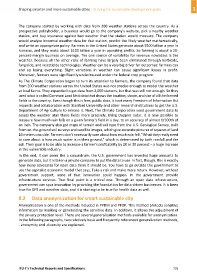Page 739 - Shaping smarter and more sustainable cities - Striving for sustainable development goals
P. 739
The company started by working with data from 200 weather stations across the country. As a
prospective policyholder, a business would go to the company's website, pick a nearby weather
station, and buy insurance against bad weather that the station would measure. The company
would analyze historical weather data for that station, predict the likely weather mathematically,
and write an appropriate policy. Farmers in the United States generate about $500 billion a year in
revenue, and they make about $100 billion a year in operating profits. So farming is about a 20‐
percent‐margin business on average. The one source of variability for revenue nowadays is the
weather, because all the other risks of farming have largely been eliminated through herbicide,
fungicide, and insecticide technologies. Weather can be a very big driver for outcomes: farmers can
end up losing everything. Slight variations in weather can cause significant losses in profit.
Moreover, farmers were significantly underinsured under the federal crop program.
As The Climate Corporation began to turn its attention to farmers, the company found that data
from 200 weather stations across the United States was not precise enough to model the weather
at local farms. They expanded to get data from 2,000 stations, but that was still not enough. So they
used what is called Common Land Unit data that shows the location, shape, and size of all the farmed
fields in the country. Even though this is free, public data, it took many Freedom of Information Act
requests and collaboration with Stanford University and other research institutions to get the U.S.
Department of Agriculture to release it. Next, The Climate Corporation used government data to
assess the weather atall those fields more precisely. Using Doppler radar, it is now possible to
measure how much rain falls on a given farmer's field in a day, to an accuracy of almost 1/100th of
an inch. The company also got maps of terrain and soil type from the U.S. Geological Survey, built
from on‐the‐ground soil surveys and satellite images, which give accurate pictures of squares of land
10 meters ona side. Farmers don't necessarily care about how much rain fell. "What they really need
to care about is how much water is in their ground," which is determined by both rainfall and the
soil. Their goal is to be able to increase a farmer's profitability by 20 or 30 percent – a huge increase
in this vulnerable industry.
In the end, it can seem like a conundrum: the U.S. government has invested huge amounts to
generate data, but it is taken a private company to put the data to use. In fact, though, this is exactly
how many advocates for open data think it should be. You have to go outside the government to
use the capitalist economic model that says, Take a risk and make more return. However, without
government support, none of that innovation could happen. In the government provide
infrastructure services. That final point is a critical one. Through an open data infrastructure,
government can spur innovation by providing the foundation for data‐driven businesses. It is been
true for GPS and weather data, and it is starting to be true for health data as well.
8.2 Data anonymization for smart sustainable city
Anonymization is one of the methods included in PPDM and PPDP. This method protects sensitive
information by masking or generalizing the sensitive data. In addition, it allows the adjustment of
the privacy protection level. There are several generalization methods available for anonymization.
In the following paragraphs, two relatively basic and frequently referenced generalization methods,
‐ anonymity and ‐diversity are explained.
ITU‐T's Technical Reports and Specifications 729

